 Most viewed - Yokohama 横浜市 Most viewed - Yokohama 横浜市 |
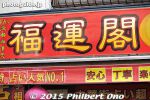
60 views
|
|
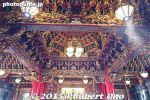
Ornate ceiling.60 views
|
|
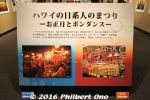
With mostly panel displays and some artifacts, this special exhibition explains New Year's customs and bon dances in Hawai’i in layman's language in Japanese.59 viewsIt is a good primer for the average Japanese to gain an understanding of Japanese culture in Hawai’i. Much of the text is based on research conducted by Japan Women's University professor emeritus Noriko Shimada whose specialty is American history. She wrote a thesis about the Iwakuni Ondo in Hawai’i so the bon dance section is dominated by Iwakuni Ondo. Photos were contributed by a number of people including Noriko Shimada, Stephanie Ohigashi, Caroline Miyata, and Ai Iwane.
|
|

Oshogatsu Panel 4 - New Year's Prayers at Shinto Shrines59 viewsBefore the war, Hawai’i had 60 Shinto shrines. Praying at a Shinto shrine during New Year's was a very important ritual for the Japanese immigrants. Today, Hawai’i has only seven Shinto shrines. Four in Honolulu (Hawai’i Izumo Taisha, Hawai’i Daijingu, Hawai’i Kotohira Jinsha combined with Hawai’i Dazaifu Tenmangu, and Hawai’i Ishizuchi Jinja), two on Maui (Maui Jinsha and Maalaea Ebisu Kotohira Jinsha), and one on the Big Island (Hilo Daijingu, Hawai’i's oldest Shinto shrine). A few of the shrines do not have a resident priest. Even today, praying at Shinto shrines during New Year's is a widely known Japanese custom in Hawai’i.
Hawai’i Izumo Taisha sees over 10,000 worshipers on New Year's Day alone. Recently, a Japanese TV program did a story on this shrine so now even tourists visiting from Japan are starting to pray here for New Year's. The shrine has about 30 different kinds of amulets (omamori) such as for finding a marriage partner, safe childbirth, warding off bad luck, etc. It also sells omamori from Izumo Taisha in Shimane, Japan.
New Year's is the biggest event at the other Shinto shrines in Hawai’i as well.
Panel photos: Top is Hawai’i Izumo Taisha on New Year's Day, bottom left is Dazaifu Tenmangu on the left and Hawai’i Kotohira Jinsha in the center, bottom center is Hawai’i Daijingu selling amulets, bottom right is New Year's at Hawai’i Ishizuchi Jinja.
|
|
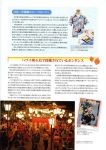
Page 4 talks about the nisei soldiers and bon dance held on six islands.59 views
|
|
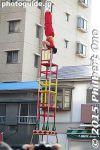
59 views
|
|
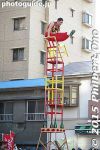
Chinese acrobat.59 views
|
|
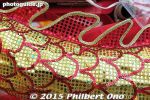
Red and gold everywhere.59 views
|
|
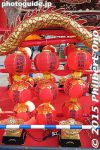
59 views
|
|
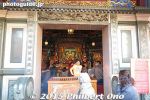
59 views
|
|
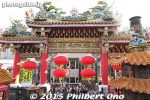
59 views
|
|

Bon Dance Panel 2 - The Beginning of Bon Dance in Hawai’i58 viewsThe bon dance likely had its beginnings in Hawai’i at the sugar plantations in the late 19th century. Feeling nostalgic, Japanese immigrants from the same region of Japan would get together and reenact the bon dance from memory.
In the early 20th century when Buddhist temples were built within the plantation camps, the bon dance started to be held at the temples. From the late 19th century, the Jodo Shinshu Buddhist Sect (Nishi Hongwanji) started full-scale propagation in Hawai’i, and other Japanese Buddhist sects also came to Hawai’i. By 1906, there were over 30 Buddhist temples in the sugar plantations on all the major Hawaiian islands.
In the beginning, people from a specific prefecture held their own bon dances. Eventually, the bon dance was held by Japanese immigrants from different prefectures. Their mindset changed from being prefecture-specific to a more collective Japanese mindset. Their culture evolved accordingly.
Panel photo: Sugar plantation workers in late 19th or early 20th century.
|
|

Places on the Big Island that hold a bon dance.58 views
|
|
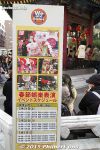
New Year's events held on the weekends following Chinese New Year's.58 views
|
|
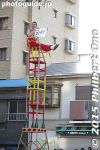
58 views
|
|
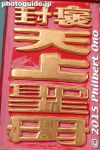
58 views
|
|
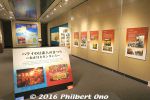
The right wall has exhibit panels explaining about New Year's (Oshogatsu) in Hawai’i.57 views
|
|
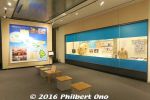
The room also has showcases displaying artifacts.57 views
|
|

Oshogatsu Panel 2 - New Year's Preparations57 viewsFor the Japanese and nikkei in Hawai’i, buying food and other things for New Year's is an important custom. To have everyone go out and buy the same things in preparation for New Year's reinforces their Japanese identity. Let's see what they sell for New Year's in Hawai’i.
At Nijiya Market, a popular Japanese supermarket in Honolulu, they sell New Year's merchandise like rice for making mochi, sake, soba noodles, soba broth, kinako, anko, kirimochhi, otoshidama envelopes, round mochi (kagami mochi), chopsticks, naruto, kamaboko, and date-maki (sweet rolled omelette). For osechi meals, they sell black beans, tazukuri sardines, kinton, fried egg, and kobumaki.
In Hawai’i, a popular members-only supermarket called Marukai imports food and merchandise from Japan. At the end of the year, the store is full of New Year's food especially osechi dishes. Almost like a supermarket in Japan.
Don Quixote has daily necessities, clothing, fish, meat, a bakery, medicines, and a Japanese food section. It also sells kadomatsu bamboo decorations, round mochi, and osechi dishes like lotus root and gobo.
Panel photos: Top is Nijiya, lower left is Marukai, and lower right is Don Quixote.
|
|

Oshogatsu Panel 1 close-up57 views
|
|

Other New Year's photos taken at various Shinto shrines in Hawai’i by Noriko Shimada.57 views
|
|
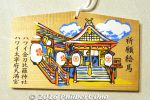
Hawai’i Dazaifu Tenmangu and Hawai’i Kotohira Jinsha ema tablet.57 views
|
|

Bon Dance Panel 5 - Bon Dances Held on Six Hawaiian Islands57 viewsIn Hawai’i, bon dances are held from June to September. During this time, a bon dance is held somewhere every weekend. (Unlike in Japan when it is held at the same time in mid-August.) The bon dance schedule is announced in May in local newspapers like the Hawai’i Herald and online.
In 2016, bon dances were held at 83 locations on six Hawaiian islands (33 on Oahu, 27 on the Big Island, 8 on Kauai, 13 on Maui, 1 on Molokai, and 1 on Lanai).
Almost all bon dances in Hawai’i are held at a Buddhist temple. A few temples even hold a lantern floating ceremony (toro nagashi). A bon dance memorial service is held before or after the dance, giving the dance a strong religious connection.
Panel photos: Top photo is a bon dance at Hawai’i Jodoshu Betsuin, bottom left is the Hawai’i Herald newspaper (Hawai’i's Japanese American Journal), bottom right is the 2016 bon dance schedule published by the Hawai’i Herald.
|
|
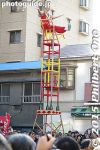
57 views
|
|
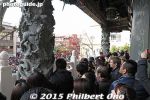
57 views
|
|

The table showcase displaying New Year's newspaper ads for Oshogatsu sales by Japanese supermarkets in Hawai’i.56 views
|
|
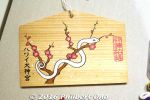
Hawai’i Daijingu ema tablet for the Year of the Snake.56 views
|
|
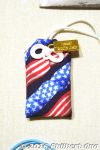
Hawai’i Kotohira Jinsha omamori with an American flag design.56 views
|
|

100th Infantry Battalion nisei's cotton khaki shirt and garrison cap. From Saburo Ishitani. Also, a 442nd RCT nisei soldier doll (nicknamed "Yoshi" or "Tak") made in 2000 and sold by a toy store in Portland, Oregon.56 views
|
|
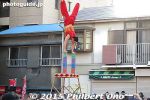
Chinese acrobat.56 views
|
|

Honolulu Star-Advertiser article (Jan. 1. 2014 issue) about mochi traditions.55 views
|
|

Oshogatsu Panel 5 - New Year's Celebrations54 viewsNew Year's celebrations continue throughout January among the Japanese-American community in Hawai’i. They're mostly held by Japanese cultural organizations.
The Honolulu Japanese Chamber of Commerce holds a New Year's party attended by about 400 people. The reigning Cherry Blossom Queen and six princesses also attend the party.
The party features iconic Japanese things like a red torii and kadomatsu at the ballroom entrance and Cherry Blossom Princesses waving a sacred Shinto wand over the attendees. The party's highlight is the humorous performance of the "Shoko Shiranami Gonin Otoko" (Shiranami Five 白浪五人男) kabuki play in English played by local businessmen. They have been performing this same play at this party every year since 1946. It's a buffet and they do not serve traditional New Year's osechi.
Panel photos: Top photo is two Cherry Blossom Princesses waving the sacred wand at the ballroom entrance under a torii, bottom photo shows the "Shoko Shiranami Gonin Otoko" play at the New Year's party.
|
|
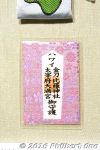
Hawai’i Dazaifu Tenmangu and Hawai’i Kotohira Jinsha omamori.54 views
|
|

Oshogatsu Panel 3 - Mochi Pounding (Mochitsuki)53 viewsIn Hawai’i from late Dec. to New Year's, Japanese Americans pound mochi mainly at private homes, Buddhist temples, and Japanese cultural organizations.
The Japanese Cultural Center of Hawai’i in Honolulu holds its Ohana ("Family" in Hawaiian) Festival every New Year's where they pound mochi. They also use this occasion to introduce other traditional Japanese things like taiko drumming, traditional Japanese dance, and kimono. It is to perpetuate Japanese culture to the younger generations.
Ringing in the New Year at Buddhist Temples (Joya no Kane)
Buddhism in Hawai’i has also been modified to suit Hawai’i. This is evident in the way they celebrate the year's end and New Year's. On New Year's Eve, members gather at the temple for a New Year's Eve service. Some temples also ring the bell before midnight.
At Honpa Hongwanji Betsuin in Honolulu on New Year's Eve, they hold a service with a sermon in English and Japanese. After the service, the congregation line up outside to ring the bell. Each person rings it once. The ministers stand nearby and shake hands with the members after they ring the bell. Then they gather in the social hall downstairs to enjoy soba noodles, black beans, and sake. It's interesting that they mix the soba noodles with saimin.
Panel photos: Top left is mochi pounding at the Ohana Festival, top right is Japanese calligraphy at the Ohana Festival. Bottom photo is temple bell ringing at Honpa Hongwanji.
|
|

New Year's programs and newspaper article from the collection of Noriko Shimada.53 views
|
|

Program for the New Year's Eve and New Year's Day services at Honpa Hongwanji Betsuin in Honolulu.53 views
|
|
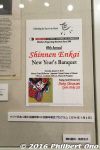
Cover of the 2014 New Year's party program by the Honolulu Japanese Chamber of Commerce.52 views
|
|
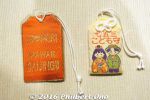
Hawai’i Daijingu omamori. The right one is for Shichi-go-san (Coming of Age) for 3 and 7-year-old girls and 5-year-old boys.51 views
|
|
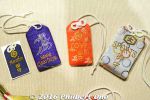
Hawai’i Izumo Taisha omamori including one for Sports and Marathon.51 views
|
|

On the left are Hawai’i Daijingu omamori and ema tablets. On the right are Hawai’i Ishizuchi Jinja omamori.50 views
|
|

20 views
|
|
|
|
|
| 797 files on 4 page(s) |
 |
4 |
|